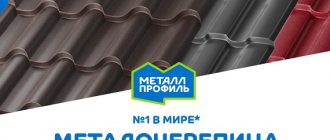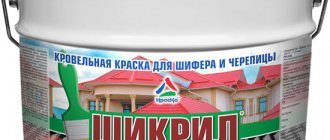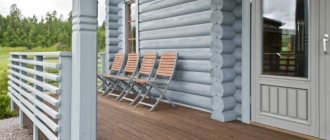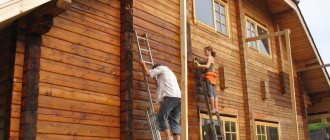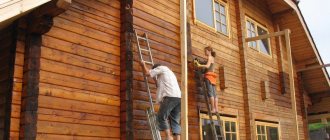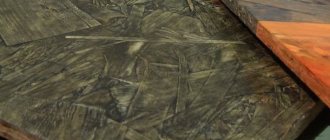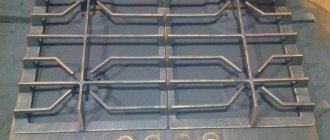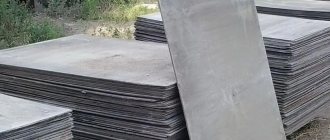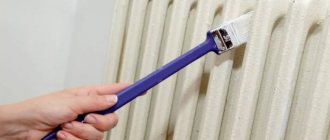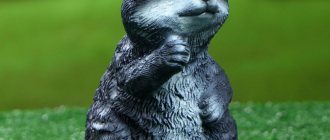If you value silence during rain, and are planning to make a roof on the roof of a new house from good old slate, this article is for you. After all, sooner or later you will come to the decision that all this stuff needs to be painted.
After all, an asbestos coating protected by a decorative layer is much less susceptible to mosses and lichens, and such a roof is more protected from chipping due to ice or wind-blown debris. But how can you paint flat slate so that it doesn’t peel off in a year? Now we will reveal all the cards!
Slate painting technology
High-quality painting of any slate should be carried out after preparation for the work and the correctly selected technology.
Tip: Hard cleaning will remove the top layer of slate, which should be covered with a deep-penetrating layer of acrylic primer. Otherwise, no paint will stick, even the most expensive one.
Tip: When preparing slate for painting, you should always dilute the primer with clean water 30% more than the volume indicated in the instructions in order to obtain good permeability of the film. Otherwise, the paint will lose its original appearance within 5 years.
When using expensive foreign paint, it is not necessary to use a preliminary primer.
Surface painting. Work order:
When applied in two layers, one square meter of flat slate will require approximately 150 grams of paint. The most durable coating will be obtained by painting the slate with two layers of paint with a break of one hour between approaches.
It is easier to paint slate on the ground, on a flat and horizontal surface. But when lifting it onto the roof, the sheet can be easily scratched.
Tip: When painting slate, the first coat of paint should be applied on the ground with a brush or roller, and the second on the roof using a spray gun.
How to prepare flat slate for painting, what to paint it with, and the specifics of the work are shown in the video in this article.
Source
How to make raised beds from slate with your own hands
Do-it-yourself raised slate beds provide several additional advantages:
- You can place the beds in any part of the garden;
- Prepared enriched soil is used to fill the structure, which increases productivity;
- here you can provide the best drainage option;
- the fence can be given any, most bizarre shape;
- It is possible to plant crops in a bed made of slate earlier, since the material provides better heat transfer to the soil and keeps the temperature of the soil in the bed at a higher level.
A fundamentally high bed differs from a regular one only in the height of the fence - at least 40–50 cm above the ground. With such a height of the walls, reinforcement of the structure is required. You can do this in 2 ways:
- fix slate to a wooden frame, as is done with very long embankments;
- tighten the walls with wire; to do this, drill holes near the edge of the strip, and when assembling the structure, connect the holes on opposite sides with wire.
After production, the bed is filled. First, lay a layer of sand or sawdust for drainage, then fertile or composite soil.
What and how to paint flat slate? Overview of market offers + step-by-step instructions
If you value silence during rain, and are planning to make a roof on the roof of a new house from good old slate, this article is for you. After all, sooner or later you will come to the decision that all this stuff needs to be painted.
After all, an asbestos coating protected by a decorative layer is much less susceptible to mosses and lichens, and such a roof is more protected from chipping due to ice or wind-blown debris. But how can you paint flat slate so that it doesn’t peel off in a year? Now we will reveal all the cards!
Advantages and disadvantages
Before covering a house with flat slate, it is advisable to familiarize yourself with the main advantages of such building materials:
- long service life (up to 30 years);
- affordable price;
- resistance to corrosion processes and biological influences;
- significant bending strength;
- inertness to temperature fluctuations;
- fire safety;
- good frost resistance;
- good soundproofing qualities;
- reflects ultraviolet light;
- does not allow electric current to pass through;
- easy to install.
Flat slate reliably protects surfaces from destructive external influences for many years Source stroy-podskazka.ru
- difficulty of transportation (due to significant weight and fragility of products);
- the need to treat the material with antiseptic agents to prevent the spread of moss;
- installation of such building materials is difficult to carry out alone;
- sawing sheets leads to the formation of asbestos dust, which is extremely dangerous for the human body;
- susceptibility to point loads.
Despite the above disadvantages, finishing the base with flat slate is used quite often today. This is due to the ability to perform installation work yourself and save money.
Helpful information! Asbestos cement sheets do not belong to the group of flammable building materials, but under the influence of open fire they are capable of “shooting”.
During the cutting process of slate, asbestos dust harmful to the human body is formed, therefore it is important to carry out all work using protective equipment Source i.ytimg.com
Why paint flat slate at all?
Many people are confused by this point: if you save on building material by purchasing slate, then why paint it with expensive paint? What then are the savings? Let's explain:
What is our task? Paint the slate with a paint that will give it an aesthetic appearance, an even and smooth coating, protect it from moisture and prevent moss from growing, and will not fade or peel over time. Plus, painted flat slate roofing looks completely different!
Fixed formwork made of smooth slate
After pouring the concrete, the constructed formwork system remains part of the foundation base. This design has many advantages:
- simplicity of the device;
- saving financial costs;
- reduction in the volume of earthworks;
- the asbestos cement material used adds strength to the foundation;
- there is no need to install additional supports.
Finishing the base of a building with flat slate using permanent formwork has disadvantages:
- complicating the assembly of the structure;
- impossibility of creating a high body.
A formwork system constructed using asbestos-cement slabs is in no way inferior to traditional wooden formwork in terms of strength characteristics.
Paints that are not suitable, as well as other errors
The result of typical mistakes when painting slate is peeling paint after just a year. That's why you can't use regular paint for slate for facades or just exterior work. The point is not only in the special structure of asbestos fibers, from which the coating not intended for it can slide off in layers within a year.
Of all the structural elements of the house, it is the roof that is completely open to scorching sun rays, hail and wind with small debris, and it also heats up the most. And all this already creates its own specific conditions for which the same facade paint was not designed at all.
Plain enamel is least suitable for painting slate. It doesn’t just flake off over time - it hangs down in whole rags, making the roof look very pitiful. Although, we note that sometimes cheap paints for metal have such high adhesion that they stick well to slate. But this is already a matter of luck.
By the way, some home craftsmen use a trick: they paint the slate with draft car paint, in two layers, with a 1:1 solvent. Surprisingly, the result of this undertaking can really please you: 5-10 paint does not fade or peel off. But this is a risky undertaking.
The quality of paint is also affected by... coloring. Often people buy paint from one manufacturer and on one base, but the coloring solution is completely different. Moreover, they mix it incorrectly. The final mixture will not show any problems, but on slate such paint will not last long. After all, chemistry is chemistry, and you shouldn’t experiment with incompatible compounds.
Do everything right:
Another reason for peeling paint on slate is snow on the roof: as soon as it melts a little and frost hits at night, an ice crust forms. She just peels off the paint. This is why it is so important that the coating layer on the slate is smooth, even slippery. For the rafter system, this point is important: the less snow is retained on the roof, the lower the variable load on the rafters. This means that the service life of the roof itself is longer.
And finally, it is usually recommended to let new slate sit for at least a year before painting.
Stages of painting an asbestos cement roof ↑
Before painting the coating, quite labor-intensive preparation is carried out. First of all, each of the sheets is checked for integrity and reliability of their fixation.
Sheets that show cracks or damage must be replaced.
The next step is to carefully clean the roof of any dirt, moss, etc. Asbestos-cement sheets are cleaned of old plaque using sandpaper and treated with an acrylic primer containing a special antifungal component. As a result of the primer, the pores of the roofing material are filled.
After the primer has dried, cement mortar is applied to the asbestos-cement sheets. The consistency should resemble kefir. A brush is used to apply the solution. Other tools, say a roller, are not suitable for this.
After allowing the cement mixture to dry completely, the roof is primed, after which the roof is painted.
When is the best time to carry out work ↑
Is it possible to paint in wet weather, when is the best time to paint? Questions that concern many, especially those who intend to handle the roof themselves. Painting of ACL must be carried out in the dry, warm season.
The paint is applied in two layers using ordinary painting tools, for example, a spray gun. The second layer is applied to the completely dry first one. Practical experience shows that painting asbestos cement sheets in the spring provides them with long-lasting protection, gives the roof a decorative appearance, and prevents the appearance of moss.
Best Paints for Flat Slate
Then how can you paint flat slate if ordinary paints are not suitable here? For flat slate, the modern market offers special impregnation paints that additionally protect such roofing from biological damage (moss, fungus and mold).
Polyurethane paints: cheap and cheerful
Polyurethane paints, after drying on slate, create a three-dimensional structure that well protects the material from contact with the environment. They resist sudden temperature changes well and have a high elasticity coefficient.
Flat slate will receive maximum protection from modern solvent-based paints. They penetrate three times deeper into asbestos fibers than water-based paints, resulting in a coating that lasts more than 20 years.
If you are looking for a cheap way to paint flat slate, then take a concentrate paint that needs to be diluted several times. But at the same time, it is better to dilute the paint itself a little less than according to the instructions.
Acrylic paints: richness of colors
These are water-dispersion paints.
Acrylic paints are good because they make slate highly hydrophobic - water easily rolls off even almost flat roofs, and snow slides off quickly. Thanks to this, the water is in contact with the slate surface for too little time, and therefore the risk of leaks is significantly reduced.
Acrylic paints for slate are also good because they fill even the most inconspicuous cracks, all the pores and unevenness of the slate.
The most popular paints in this series:
Important advice: to paint flat slate with acrylic paint, you need to wait for weather from +5°C to +35°C, clean and dry the sheets well and let them dry for 1-2 hours. In total, the polymerization process will take about a day.
Silicone paints: water-repellent properties
Unfortunately, on the windy side of the roof, such paint can fade to almost gray in 10-20 years.
Acrylic-silicone paints: best qualities
A relatively recent innovation on the market is acrylic-silicone paints. They combine the better qualities of both acrylic and silicone compounds.
So, for example, if you want to protect slate from dirt, cracks, mold and damage from water, then purchase VDAK-1283 paint. This material has good water-repellent properties and has undergone serious testing during the production process: 90 cycles without changing the protective properties in a special chamber. This suggests that such paint will behave remarkably well in the Russian climate for at least 10 years. And, what’s good, it can be tinted according to the RALL and NCS catalogs.
In Russia, the largest producers of such paints are Penta, Tiprom and Sofexil.
Liquid rubber: perfect coverage
If you have noticed, recently more and more experts recommend painting slate roofing with rubber paint. It includes special materials that ultimately create a dense protective film on the surface, elastic and durable. It never delaminates – even over time and in harsh terrain. And special pigments prevent the color from fading even after 5 years.
The only serious drawback of rubber paints is their toxicity. Therefore, you will need to work with such paint outdoors without strangers and with mandatory hand and respiratory protection.
One of the most popular rubber paints for slate is Super Decor. You need to paint it in sunny, dry weather - this is the only requirement. There are also good reviews about Rezolux rubber paint, which is sold together with a special primer.
Interesting video about rubber paint:
Liquid plastic: new technologies
And this is already a completely new word in science:
Features of asbestos cement
Slate is made from asbestos cement and can withstand any external influences - rain, exposure to sunlight, etc., it only cannot withstand heating. But usually summer residents do not light fires next to the ridges, so asbestos-cement sheets are perfect for framing the ridges.
Wavy or flat slate is almost always present on the site - these can be old sheets removed from the roof of a dacha or outbuildings. Asbestos-cement sheets are quite fragile, and a flat asbestos-cement sheet is less durable than a wavy one - the waves add additional rigidity. Therefore, it is better to make beds from wave slate.
Strips for beds made of such fabric should be cut across the waves. In this case, the strips will be short, but stronger than those sheets that are cut along the waves.
Ideally straight sides are made from flat sheets of asbestos-cement material. But such sides will be more fragile, so experienced summer residents recommend strengthening the walls along the perimeter of the bed with wooden or metal pins dug into the ground. You can fasten the corners of the sides together with metal corners and bolts. Level areas are fastened with metal strips and bolts.
Attention! Slate is a material intended for roofing work.
Flat and wavy asbestos-cement sheets can be of different thicknesses, lengths and widths, have different weights and colors.
Advantages of asbestos-cement sheet as a material from which sides for beds are made:
- the canvas is not too heavy, you can quickly make sides for beds from it;
- asbestos cement is resistant to temperature changes, does not ignite, is not subject to corrosion, and is not afraid of moisture;
- the material does not rot;
- these sheets can be used for about 9 years;
- Asbestos-cement sheets are easy to work with;
- raised beds made of slate look very beautiful.
Slate has practically no disadvantages:
- he is fragile;
- When heated for a long time, it can burst and fly into small pieces.
Important! In open or closed ground, it is better to use fences made of these sheets for annual vegetable crops.
If you dig asbestos-cement fences deeply, then “harmful” bugs will not crawl from the soil to vegetable crops, and the roots of weeds will not be able to overcome such a fence. But the canvas is too thin and quickly heats up under the influence of the sun's rays. Because of this, the moisture in such a garden evaporates faster, so you have to water the vegetable plants more often.
Some experts argue that slate dug into the soil harms plants and soil. Indeed, the asbestos that is part of such a canvas begins to decompose over time and releases toxins that poison the soil.
To prevent such a disaster, factory-painted sheets should be used in the construction of sides. If you have unpainted asbestos-cement sheets available, you can paint them yourself using the paint you have on hand.
How is flat slate painted at the factory?
You will be interested to know how slate is painted in production. So, the simplest technology is to apply paint to the outside of the sheets. But such slate is just “painted”. If additional surface protection is necessary, then a layer of paint is applied not only at least twice, but also under special conditions: conveyor lines heated to a certain temperature.
Many home craftsmen try to replicate this technology in their own yard: they simply lay flat slate on the grass on a hot sunny day, and it heats up from the rays. Then they paint and admire the resulting beautiful and durable roof. Tricky, isn't it?
Sometimes, of course, a special pigment is added directly to the raw material mixture, and then the slate is produced “colored”. Its advantage is that such slate does not fade at all, and when cut, the edges have the same color as the sheet itself. Even severe scratches will not be noticeable. But such slate costs much more than usual.
That’s why some manufacturers use a combined option: because slate, like plywood, consists of several layers; only the top one is painted. In other words, the top layer is deeply saturated with paint, and not just painted. And it is only 10% more expensive than regular gray.
How to arrange row spacing
Such structures are most often made in areas located in the central zone of our country, in Siberia and the Urals, where the climate is harsh. And vegetables growing in such beds develop well, despite the variability of weather conditions in these regions.
Therefore, the question is reasonable: how to arrange row spacing among such beds correctly?
Well-equipped row spacing enhances the aesthetic appearance of the garden and also serves as additional reinforcement for slate fences. After the fences are dug in and filled with soil, the soil should be compacted well between the rows. And the further arrangement of paths between the high beds depends on the imagination and capabilities of the summer residents: the spaces between the rows can be concreted, laid with special tiles or decorated with other materials.
Step-by-step instructions for painting work
Proper painting of flat slate requires proper preparation and the right technology.
Stage 1: Cleaning
First, thoroughly clean the slate. And if you need to paint old material, then in addition to a synthetic brush you will also need a metal one to remove all the moss and lichen.
Such a harsh cleaning will, of course, remove the top layer of slate, and therefore it will need to be coated with a layer of deep-penetrating acrylic primer. If this is not done, no paint will stick, no matter how expensive it is.
Stage 2. Inspection
The second step is to carefully inspect the slate for cracks. Before painting, flat slate must be thoroughly cleaned and even repaired. If the crack is very thin, like a thread, then you don’t need to do anything with it: a couple of layers of paint will flow into the crack and the problem will be solved.
For a wider crack, you will need to make a patch. To do this, take fiberglass (burlap and tarpaulin will do in a pinch), saturate it with thick exterior paint, coat the crack itself and plug the patch. Let dry and paint again.
Stage 3. Processing
The third step is to treat the surface with antifungal drugs. As practice shows, they significantly increase the service life of roofs made of this material.
Stage 4. Primer
The fourth step is to prime the flat slate with the special compounds recommended by the paint manufacturer. This treatment ensures reliable contact between slate and paint. If you skip this step, the paint itself will lag later.
Please note that if you are preparing slate before painting, always dilute the primer with 30% more water than stated in the instructions, otherwise you will get a poorly permeable film. The paint will adhere to it, but not firmly and after 5 years it will lose its appearance.
By the way, if you purchased expensive foreign paint, it is not necessary to use a primer first.
Stage 5. Painting
Before use, be sure to mix the paint well so that the coating is uniform. Is it starting to thicken? So dilute with a small amount of bitel acetate or white spirit.
Paint should be applied to flat slate only after completing the following steps:
Flat slate should only be painted in a horizontal position: this is the only way the paint will evenly fill all the unevenness and roughness. But in a vertical position such an effect cannot be achieved.
Based on two layers, for each square meter of flat slate you will need about 100-200 grams of paint. The most durable coating is obtained if you paint flat slate in two layers of paint, leaving a break of one hour between approaches.
But here’s a rather important question: where is it better to paint flat slate – on the ground or on the roof? On the ground, of course, it is easier, and the necessary horizontal line is created for a flat surface of the coating. But when climbing onto the roof, already painted slate can easily be scratched. So what to do? Experienced builders do this: the first layer of paint is applied on the ground, using a brush or roller, and the second - already at height and with a spray gun.
But what to do if the slate is already painted in the desired color, and you don’t want to change it? Do I need to apply a new coat of paint? If the only problem is that moss is constantly growing on the flat slate, you can even solve the problem with colorless hydrophobic impregnation. Its secret is that now oxygen does not reach the roots of the spreading plants, and the moss will simply fall off. As a result, the slate is cleaned and even brightens.
Source
Advice from experienced gardeners
To properly arrange warm slate beds with your own hands, you need to adhere to the following recommendations:
- The embankments should be oriented from east to west - this ensures the best lighting conditions;
- when constructing high beds, slate is immersed to a depth of at least half the height of the fence;
- to ensure a higher yield, compost is placed at the bottom of the structure and then covered with a layer of garden soil;
- Slate beds in a greenhouse are made in exactly the same way; the advantage here is the ability to organize drip irrigation of any complexity;
- You can sow lawn or meadow grass between the beds; this will make the yard or garden more tidy.
Slate beds do not require additional care. However, if the material is damaged, it must be replaced.
Painting slate: overview of types of coloring compositions + technology of work
The abundance of modern roofing materials sometimes makes you think that slate is irrevocably out of fashion. It's kind of gray and dull. And in terms of design, it cannot keep up with the multi-colored sheets of bitumen ondulin, roofing plastic or polycarbonate. However, thoughts about slate being unattractive are a common misconception that arises against the backdrop of advertising campaigns by manufacturers of expensive roofing coatings.
In fact, in order to bring the decorative properties of asbestos-cement sheets closer to the same ondulin, it is enough to... paint them. It is not difficult. Moreover, slate paint is not a scarce material and can be found in any construction supermarket. Let's figure out what you can use to paint a slate roof and how to do it correctly.
Options for decorating beds with slate
This material is durable, but not elastic. It is not suitable for creating curved fences. But all other design methods can be implemented. Do-it-yourself slate beds in the photo demonstrate all types of design:
- correct outlines - rectangular and square shapes are now the most common solution, it is the easiest to make such a bed, and in this case it is more convenient to care for the plants;
- if slate is used to decorate a flower bed or flower garden, they try to make the fences more decorative; it is used to build polygonal flower beds, beds with beveled corners, triangular, diamond-shaped;
- slate can be used when organizing a multi-tiered bed - vertical, the material has sufficient strength;
- although it is not elastic, it can be used to make a flower bed with rounded corners.
Since the natural color of the material is unattractive, it is recommended to paint such a fence.
A flowerbed of any shape can be created by cutting the material into small pieces across the wave. The smaller the width of the strip, the easier it is to construct from them a fence of any curved shape, even for a regular circle. This option is very decorative, but its arrangement requires a lot of time and effort. In addition, this method is not suitable for high beds.
Why do you need to paint slate at all?
The fact that the use of paints allows slate to achieve the desired color is understandable. But besides the decorative function, coloring compositions also have more important properties. Let us remember that slate is a porous material, prone to the formation of microcracks. Water easily gets into them, which with the onset of winter cold turns into ice and begins to “tear” the fibers of the material. The same deforming processes occur when mosses and lichens grow in the pores. The problem of premature destruction of slate is solved by painting. Coloring compounds form a durable film on its surface, blocking access to asbestos cement to water and microorganisms. As a result, deforming processes are suspended and the slate gains additional years to its service life.
Painted slate, thanks to the paint film, becomes smooth. It does not retain atmospheric moisture and snow melts off easily. And if dirt accumulates on the roof, you can simply wash it off with water from a hose or car wash.
Another problem that can be solved by painting is the theoretical harmfulness of slate. The version that asbestos-cement sheets are not environmentally friendly came to us from the West and is successfully cultivated by many manufacturers of more expensive and modern roofing materials. Its essence is that slate during operation emits asbestos dust, which is harmful to the environment and human health. There is much evidence that this opinion is unfair, however, if this aspect bothers you, paint applied to the slate will completely block the possible release of asbestos dust and will 100% preserve your health.
Thus, staining slate allows you to:
How to work with asbestos-cement coating
Work with asbestos-cement sheets should be carried out following a number of certain rules. This material is easy to process, but some precautions are required. Cutting strips of asbestos-cement cloth should be done with a grinder. At the same time, a large amount of fine dust containing asbestos is released into the air. This dust can get into a person's eyes and nasopharynx. Therefore, before starting work with such sheets, you should protect your eyes and mouth with a respirator and special glasses. It is advisable to cut the strips so that the wind blows the dust away.
Types of paints for slate
There are a lot of requirements for slate paint. Its resistance to fading, exposure to high and low temperatures, and precipitation is valued; degree of adhesion to asbestos cement.
In any case, you cannot paint slate with anything, the first paintwork material you come across. The following options for suitable paints are available:
Let's consider the properties of each type of coatings separately.
The most extensive group consisting of acrylic-based paints. Their color is intense, with varying degrees of matte (both matte and glossy effects are possible). There are two types of such compositions: water-soluble (water-dispersed) and organic solvents.
Type #1 - water-based acrylic paints
They contain aqueous dispersions of acrylic copolymers (latexes), coloring pigments and various additives (biocides, antifreeze, etc.) in an aqueous environment. Water is used as a diluent for this composition - no more than 5-15% of the total volume.
Water-based acrylic paints:
Among the most famous and reliable water-based acrylic paints are:
A special type of water-based acrylic coatings is rubber (latex) paint. It contains the same acrylic latex, pigments and additives as conventional water-dispersed materials. But, unlike them, latex paint resembles a thick mastic, which, after drying, forms an elastic film, flexible like rubber. It absolutely does not allow water to pass through, does not crack, and has high adhesion to porous materials, including slate. The latex film of paint tightens cracks up to 1 mm wide and prevents the appearance of new ones. A prominent representative of this LMK group is “Rubber Paint” from Novbytkhim (Russia).
The properties of acrylic paints for slate using the example of a specific Eurostil Nova coating from Supraten (Moldova) are discussed in the following video:
Type #2 - acrylic paints with organic solvents
These paints are not diluted with water, but with organic solvents. Contains: acrylic resin (synthetic latex), color pigments, additives, organic solvent (most often white spirit). The degree of matte finish of such paints depends on the resin content. The more it is, the more pronounced the gloss of the dried film of the composition.
Organic solvent paints are different:
Solvent-based acrylic paints are presented in a small range on the market. Thanks to its excellent quality, matte paint “Eternit” from Polifarb (Ukraine), produced in red, brown and green, has proven itself among craftsmen. Due to its wear resistance, the color of this paint practically does not change even at the end of its service life. Another popular option is Shikril paint from KrasKo (Russia). It is easy to use and has a high degree of coverage.
Type #3 - organosilicon (silicone) paints
Organosilicon paints are rightfully considered the most reliable and durable for slate. They are suspensions of pigments and fillers in an organosilicon (silicone) binder. Due to the presence of silicone, this type of paint is characterized by increased elasticity, so some of them are able to bridge cracks up to 2 mm thick!
Properties of silicone paints:
Repeatedly tested for painting slate enamel “KO-slate”, produced (Ukraine). It impregnates the top layer of slate, providing deep, long-lasting color. The company produces “KO-slate” in two colors – red-brown and green, but there is the possibility of custom tinting.
The same company produces enamel OS-5103K (color green), intended for protective and decorative painting of many materials, including asbestos cement. The material has increased heat resistance, acid and alkali resistance, and resistance to chemical gases. Thanks to this, painting slate with OS-5103K enamel can be done at industrial enterprises.
Type #4 - alkyd slate paints
The composition of alkyd slate paints consists of alkyd resins, pigments, fillers in an organic solvent. Alkyd enamels, as a rule, dry quickly and form an elastic film that is not prone to cracking.
Properties of alkyd slate enamels:
An example of high-quality alkyd enamel is “Quick-drying enamel for slate” from (Ukraine). It is characterized by very fast drying (at 20˚C the layer dries in 1 hour) and has no pungent odor. Available in the most suitable colors for the roof: red, brown, blue and green. Another alkyd-based product is “Roof Enamel” produced by Empils (Russia). In addition to high protective qualities, the paint has a wide tinting base consisting of 10 colors.
Type #5 - polymer paints “Liquid plastic”
They are a suspension of polymers (polyurethane, vinyl or polystyrene), pigments and additives in a solvent. After the composition dries and the solvents evaporate, the paint forms a thin plastic (polymer) layer with a glossy or matte surface on the slate.
Characteristics of “liquid plastic”:
Reliable polymer paint Liquid Plastic is produced by Denalt (Canada). This paint is produced on an alkyd-polyurethane base, which gives the composition special strength.
Polymer paint PPG-1 produced by Komoil (Belarus) is another reliable choice. Its composition contains polystyrene, which, after drying, forms a protective and decorative coating of various colors. Ps-160 paint (Ukraine) also has a polystyrene base. It is a weather-resistant enamel that forms an elastic surface with a glossy effect.
Is it possible to paint and with what ↑
You can often hear that paint for flat slate is very short-lived - one winter is enough and it will crumble. Undoubtedly, this cannot be ruled out, but only for those cases when it is chosen incorrectly. Let's try to figure out what and what paint is best to paint with.
Types of paint ↑
Typically, asbestos is painted with one of the following materials:
- containing acrylic;
- quick-drying;
- liquid plastic.
The last of them is perhaps the least suitable for asbestos-cement roofing. Unlike the other two, it is less weather-resistant, and also has a rather pungent, unpleasant odor.
Enamel with a quick-drying composition gives the roof an exceptional decorative effect. This finish is resistant to weather conditions and UV radiation. The consumption of this material is 100–150 g per square meter. m. The performance characteristics of the coating are maintained for 3–5 years.
It is no coincidence that acrylic compounds are used predominantly for painting ACL. It is considered the most durable and safe of the above. After applying the composition, a moisture-proof film is formed on the roof surface, which, if properly applied, does not collapse for at least ten years. Acrylic coatings create a smooth surface along which rain and melt water flows freely and snow melts off, reducing the load on the supporting structure of the roof.
The latter is very important, given the significant load from the asbestos-cement sheets themselves.
It takes more acrylic than a quick-drying composition to cover a unit area - about 0.3 kg per square meter. m. Acrylic compositions
- environmentally friendly,
- do not have harmful secretions,
- wear-resistant,
- dry quickly,
- provide increased adhesion.
- completely fill all cracks, and the resulting sufficiently strong layer effectively protects the material from destruction.
When applying paint to the roof, you must strictly adhere to the manufacturer's recommendations - they are usually marked on the packaging.
- Bitumen compositions are moisture- and frost-resistant and have an affordable price. However, they are toxic, wear out easily, are not aesthetically pleasing, and require a long time to dry.
- Silicone compounds extend the service life of the roof, are non-toxic, resistant to atmospheric influences, but are quite expensive and this comes with significant paint consumption.
- Special oil enamels are distinguished by a wide variety of shades and durability. They take quite a long time to dry, about six hours, and their service life is about three years, which is undoubtedly not very long.
- Organosilicon paint is a mixture of dyes and fillers. The basic component of this composition is silicone. This is a durable material that is resistant to mechanical stress. Such a protective layer prevents the release of asbestos particles into the atmosphere. Such compositions are only suitable for this type of coating and require careful treatment of the base using a silicone primer. To give greater durability, the paint is applied in at least two layers.
Variety of colors and tinting options
The most popular paint colors for slate are red, brown, and green. They appear in the range of most paints. At the same time, the color base of a particular material can include either 5 or 100 different colors and shades. But what to do if you want to paint the slate, say, light yellow, but the selected paint does not have such a shade in the range? Tinting will come to the rescue. Most paint manufacturers provide the ability to paint their paints in any tone corresponding to color catalogs - RAL, NSC, Symphony. Tinting at the enterprise is carried out using special equipment, using tinting pastes and paints.
You can also do the tinting yourself by adding tinting paste to the purchased paint and stirring the mixture with a mixer.
Slate coloring technology
The choice of paint and its color is a responsible process. But, unfortunately, even the most expensive and high-quality enamel cannot guarantee a reliable decorative and protective coating on slate. If you do not follow the painting technology, then the pigmented film will almost certainly behave unpredictably. For example, it will begin to crack, swell or crumble much earlier than the end of its service life (possibly even a few days after painting). Therefore, you also need to know how to paint slate correctly!
The process of painting slate is carried out in several stages:
Stage #1 - preparing the slate surface
The slate surface to be painted must be cleaned of dust, dirt, fungal and plant deposits, and unstable (or incompatible with the chosen paint) coatings.
Cleaning can be done in two ways: dry mechanical (manual or mechanized) and using pressurized water jets. Sometimes these methods are combined and performed alternately.
For manual mechanical cleaning, wire brushes are used to scrape off efflorescence, dirt, moss and lichens. The work requires considerable effort and accuracy, and the cleaning speed is very low. You can clean slate faster and better with the help of tools. To do this, put an attachment on a grinder or drill, which is essentially the same brush for metal. When the tool is turned on, it begins to rotate, cleaning off surface defects of the slate.
The second cleaning method is to wash the slate with high-pressure water jets, which are created by car mini-washes (Wagner, Karcher, etc.). In this case, the created pressure should be within 100-250 atmospheres. Mini washers that release water at a lower pressure will not be able to remove contaminants, while higher pressure mechanisms will destroy not only the defects, but also the slate itself.
Stage #2 - priming
To impregnate the top layer of slate, special compounds are used - primers. They are selected in accordance with the instructions for using the specific coloring composition. For example, organosilicon paint Ko-slate is combined with silicone primer KO-011S. However, organosilicon paints, as well as “Liquid Plastic” compositions and alkyd enamels can be applied without prior priming. Acrylic paints, on the contrary, require the use of a primer. These can be either special compositions (for example, Dupa-grund for Alpina DACHFARBE) or paint diluted according to the instructions. To obtain an impregnating primer for Alpina DACHFARBE acrylic paint, it is enough to dilute it with water to 10% of the volume.
The primer is applied to the slate in 1-2 layers using a brush, roller or spray gun.
